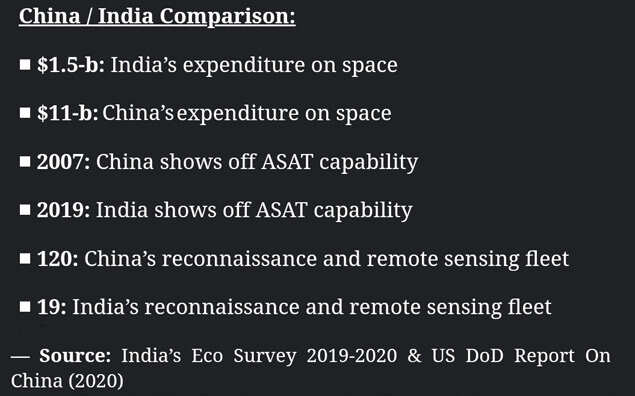From Robots To Satellite Jammers, China Looks To Space To ‘Blind & Deafen Enemy’: Us Report

BANGALORE: Notwithstanding its public stance, China, led by the People's Liberation Army (PLA), is strengthening its space prowess and continues to develop and acquire a variety of space capabilities designed to limit or prevent an adversary's use of space-based assets during crisis or conflict.
The PLA continues to acquire and develop technologies including kinetic-kill missiles, ground-based lasers, and orbiting space robots, as well as expanding space surveillance capabilities which can monitor objects in space within their field of view and enable actions, a 200-page annual report to the US Congress prepared by the Department of Defence revealed.
China is developing electronic warfare capabilities such as satellite jammers, offensive cyber capabilities and directed-energy weapons.
When the findings of the report are juxtaposed with India’s own capabilities, the latter appears to be lagging behind, both economically and militarily, even as ISRO and DRDO are both working towards enhancing strategic capabilities, including laser weapons.
For instance, by the end of 2018, China had a reconnaissance and remote-sensing fleet consisting of more than 120 satellites designed to collect data for civil, commercial, or military owners as well as operators and PLA owns half of this.
Comparatively, India has about 10% of this in its remote sensing constellation. With multiple launches late last year, including the CARTOSAT-3, India has 19 such satellites orbiting actively, according to ISRO. Also, while India too has displayed its anti-satellite ability last year (China did it in 2007), its space program lags behind in several other aspects.
Speaking to TOI, ISRO chairman K Sivan said, “Building military space capabilities doesn’t directly come under the department of space. That said, all strategic needs will be met, our focus has largely been on the civilian side and even there we have certain gap areas. Whatever is required for the strategic needs will also be done by ISRO, and we will also see private contributions in this area as we’ve seen with DRDO missiles and so on.”

One reason for this could be poor investment.
The Chinese government, according to the Economic Survey 2019-2020, has spent 7 times more than India on its space program ($11 billion compared to $1.5 billion) while other global reports show that China has been more aggressively launching military satellites compared to India.
China’s space industry, historically managed by the PLA, is rapidly expanding its intelligence, surveillance, and reconnaissance (ISR), navigation and communication satellite constellations. The PLA Strategic Support Force’s (SSF) strategic space, cyber, and psychological warfare capabilities and missions are not bound by geographic constraints and can be used independently or to enable and support PLA global power projection operations.
ASAT & More
In addition to the development of directed-energy weapons and satellite jammers, the PLA has an operational ground-based anti-satellite (ASAT) missile — a capability India demonstrated last year — intended to target low-Earth orbit satellites, and China probably intends to pursue additional ASAT weapons capable of destroying satellites up to geosynchronous Earth orbit.
“ ... Although the PRC has not publicly acknowledged the existence of any new programs since ASAT in 2007, the PLA’s defence academics often publish on counterspace threat technologies. These scholars stress the necessity of destroying, damaging, and interfering with the enemy’s reconnaissance ... and communications satellites, suggesting that such systems, as well as navigation and early warning satellites, could be among the targets of attacks designed to 'blind and deafen the enemy,'" the report reads.



No comments:
Post a Comment